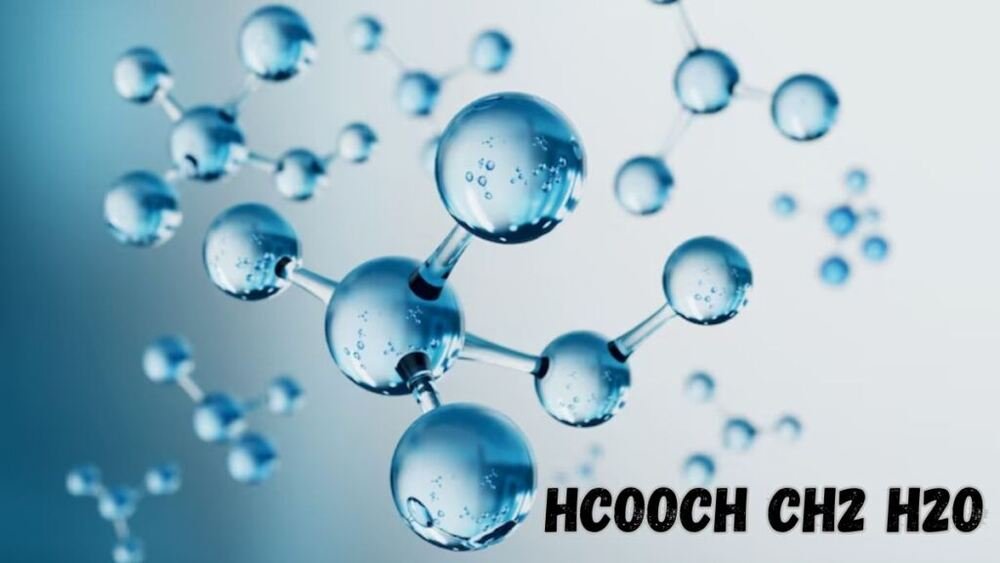HCOOCH + CH₂ + H₂O – Hydrolysis of Methyl Formate Explained
Introduction to HCOOCH, CH₂, and H₂O Reaction
The chemical expression hcooch ch2 h2o represents a reaction involving methyl formate (HCOOCH₃), a CH₂ group, and water (H₂O). While the formula may initially seem ambiguous, it reflects a broader class of reactions in organic chemistry known as ester hydrolysis, where an ester compound reacts with water to produce a carboxylic acid and an alcohol. This transformation is one of the most fundamental and widely taught reactions in both academic chemistry and industrial processes. Specifically, methyl formate undergoes hydrolysis in the presence of water to yield formic acid and methanol, two essential chemicals with extensive industrial and laboratory applications. Understanding this process provides insights into reaction mechanisms, chemical equilibrium, green chemistry, and analytical methods for compound identification.
Understanding Methyl Formate (HCOOCH₃)
Methyl formate, chemically denoted as HCOOCH₃, is the simplest formate ester and is synthesized through the esterification of formic acid (HCOOH) and methanol (CH₃OH). It is a colorless, highly volatile liquid with a pleasant odor, often used as a solvent or intermediate in organic synthesis. Methyl formate is not only crucial in industrial chemistry but also serves as a model compound in understanding ester reactions. It has a boiling point of approximately 31.5°C, making it suitable for use in low-temperature reactions. Structurally, it comprises a formyl group (HCO–) bonded to a methoxy group (–OCH₃), forming a classic ester linkage. This linkage is crucial to its reactivity with nucleophiles, such as water.
Role of CH₂ in the Reaction Mechanism
The CH₂ fragment commonly represents a methylene group, which can appear in organic structures as a part of a longer carbon chain or as a reactive unit in intermediates. In ester hydrolysis reactions, CH₂ may not be a direct reactant but symbolizes structural fragments that can influence the molecular geometry and reactivity of the compound. In some interpretations, CH₂ in “hcooch ch2 h2o” could imply an additional carbon-containing reactant or an identifier of a structural motif. However, in most academic discussions, it is treated as either part of a larger chain or a simplification to indicate chemical involvement during transformation. In methyl formate, CH₂ is part of the methanol produced after the hydrolysis process.
Water (H₂O) as a Reactant
Water is more than just a solvent in chemical reactions—it is a powerful nucleophile and reactant, particularly in hydrolysis reactions. When methyl formate undergoes hydrolysis, water molecules attack the electrophilic carbon in the ester bond, initiating the breakdown of the compound. This reaction typically requires an acidic or basic catalyst to proceed efficiently. Under acidic conditions, the carbonyl oxygen becomes protonated, increasing the electrophilicity of the carbon atom and facilitating the water molecule’s easier attack. Under basic conditions, hydroxide ions (OH⁻) act as stronger nucleophiles, quickly attacking the carbonyl center. In either case, water plays a crucial role in transforming an ester into a carboxylic acid and an alcohol.
Balanced Chemical Equation
The simplified and balanced chemical equation for this reaction is:
HCOOCH₃ + H₂O → HCOOH + CH₃OH
Here, methyl formate reacts with water to yield formic acid and methanol. The reaction is a classic example of ester hydrolysis, exemplifying the transformation of an ester group (–COOR) into a carboxylic acid (–COOH) and an alcohol (–OH). The stoichiometry of the reaction exhibits a 1:1:1:1 molar ratio among the reactants and products, facilitating easy analysis in laboratory settings and subsequent scaling up for industrial use.
Hydrolysis Mechanism of Esters
The hydrolysis of esters, such as methyl formate, proceeds through a nucleophilic acyl substitution mechanism. In acid-catalyzed hydrolysis, the carbonyl oxygen of the ester is first protonated by an acid catalyst, increasing its electrophilic character. Water then attacks the carbonyl carbon, forming a tetrahedral intermediate. Subsequent proton transfers and elimination steps lead to the formation of a carboxylic acid (formic acid) and an alcohol (methanol). In base-catalyzed hydrolysis, hydroxide ions directly attack the carbonyl carbon, bypassing the need for protonation and leading to a more irreversible saponification-type reaction. In both pathways, the reaction demonstrates the importance of electron flow and transition states in organic transformations.
Reaction Conditions and Optimization
Optimizing the hydrolysis of methyl formate involves controlling various parameters, including temperature, pressure, and catalyst concentration. Typically, a slightly elevated temperature accelerates the reaction without causing it to decompose. Acidic conditions, using dilute hydrochloric acid or sulfuric acid, are commonly employed in laboratories to promote the reaction. In industry, catalytic systems are chosen based on efficiency, cost, and ease of separation. Pressure conditions may vary depending on whether the reaction is carried out in an open or closed system. The pH of the solution also influences the reaction rate and product yield, with acidic environments generally being more favorable for ester hydrolysis.
Industrial Applications
Hydrolysis of methyl formate is not just an academic exercise—it has profound industrial significance. Formic acid, one of the products, is used in textile processing, leather tanning, rubber production, and as a preservative in animal feed. It also plays a role in fuel cells and green chemistry applications. Methanol, the other product, is a critical feedstock in the synthesis of formaldehyde, acetic acid, and methyl tert-butyl ether (MTBE) and also serves as an alternative fuel source. The ability to efficiently convert methyl formate into these valuable chemicals makes this reaction essential in various manufacturing pipelines.
Environmental Impact and Safety
Despite its usefulness, the reaction involving HCOOHCH2H2O must be managed carefully. Methyl formate is highly flammable, and both it and methanol pose health risks through inhalation or skin contact. Proper ventilation, storage away from open flames, and the use of personal protective equipment (PPE) are crucial when handling these substances. On the positive side, the hydrolysis reaction is relatively eco-friendly, mainly when carried out in aqueous media without the use of harmful solvents. Waste products are minimal, and with proper management, the reaction aligns well with green chemistry principles, focusing on efficiency, low toxicity, and minimal environmental harm.
Related Chemical Reactions
The hydrolysis of methyl formate is just one example of a broader class of reactions involving esters. The reverse reaction, known as esterification, occurs when a carboxylic acid reacts with an alcohol in the presence of an acid catalyst to form an ester and water. Other similar esters, such as ethyl formate and propyl formate, undergo comparable hydrolysis mechanisms, producing different alcohols while maintaining the exact yield of formic acid. Comparing these reactions helps students and researchers understand how molecular structure influences reaction behavior.
Analytical Methods for Monitoring Reaction
To study or monitor the HCOOH · CH2O · H2O reaction, chemists use several advanced analytical tools. Gas Chromatography-Mass Spectrometry (GC-MS) can identify and quantify methanol and formic acid in the reaction mixture. Infrared (IR) spectroscopy enables the observation of functional group transformations, such as the disappearance of the ester carbonyl stretch and the appearance of the acid OH stretch. Nuclear Magnetic Resonance (NMR) spectroscopy offers detailed insights into structural changes, particularly the proton environments, before and after the reaction. These techniques help optimize reaction conditions and ensure product purity.
Educational Relevance in Organic Chemistry
This ester hydrolysis reaction is a cornerstone in organic chemistry education. It introduces students to essential concepts like functional group interconversion, reaction mechanisms, and thermodynamics. Performing this reaction in the lab allows students to witness firsthand how esters behave in aqueous environments and under catalytic conditions. The simplicity of the response also makes it ideal for demonstrating chemical equilibrium, pH control, and separation techniques such as distillation and extraction. Teachers often use this reaction to bridge the gap between theoretical knowledge and practical application.
Future Research Directions
Future research into ester hydrolysis reactions, such as HCOOCH2H2O, focuses on increasing sustainability, reaction efficiency, and catalyst innovation. Scientists are exploring biocatalysts, such as enzymes, that can perform ester hydrolysis under mild, environmentally friendly conditions. Additionally, nanomaterial-based catalysts and microwave-assisted hydrolysis are being explored to reduce energy consumption and enhance conversion rates. Computational chemistry and machine learning are also being used to model and predict reaction behaviors, potentially revolutionizing how these transformations are optimized in the future.
Conclusion
In summary, the hcooch ch2 h2o reaction—hydrolysis of methyl formate—is a fundamental and highly informative chemical transformation. It showcases how simple molecules can undergo structural changes through the action of water, yielding valuable products like formic acid and methanol. This reaction is essential not only in chemical education but also in real-world industrial processes. As the world continues to focus on sustainability and efficiency, understanding the mechanics, conditions, and implications of such reactions becomes increasingly essential.
Do Read: MLA Citation Generator – Best Free Tools & Guide (2025)


